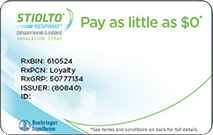8.10 Assisting Uninsured Patients
Despite the passage of the ACA, approximately 10% of people in the United States still do not have any type of health or drug insurance. Many are the “working poor.” Some could qualify for subsidized coverage for healthcare exchanges under the ACA, but they are not aware of this option, they don’t know how to apply, or their states have not expanded coverage to include them. The first step to helping those struggling with healthcare insurance is to encourage them to check out the healthcare exchange for shopping online for an affordable program. They may also be eligible for their state’s Medicaid or state-run healthcare assistance programs.

A pharmacy technician can make a real difference in the life of an uninsured or underinsured patient by helping him or her find the resources or coupons needed to afford a necessary medication.
 IN THE REAL WORLD
IN THE REAL WORLD
In one community pharmacy, an uninsured patient came in requiring an antibiotic for a severe sinus infection resistant to the lower-cost antibiotics. The AWP of the needed antibiotic was $106. The pharmacy technician notified the pharmacist, who looked up the actual cost to the pharmacy for the antibiotic and decided to reduce the price to $30, which the patient could pay.
Another uninsured patient with diabetes brought in a prescription for Janumet, a marketed brand name that combines two drugs. The cost for a one-month supply was over $300! The pharmacy technician suggested that it might be cheaper to pay for the two drugs (sitagliptin and metformin) separately if the prescriber approved. Unfortunately, the cost was still very high. So the technician looked up Janumet on the manufacturer drug coupon site and found a drug manufacturer discount card that provided a free 30-day supply and discounts on the next 12 refills, which made the remaining drug affordable. This act of customer service made an immense difference in this customer’s quality of life. This useful website can be accessed at https://PharmPractice7e.ParadigmEducation.com/ManufacturerCoupon.
As a technician, there are steps to take specifically when patients come in with prescriptions that they can’t afford. Some technicians in large chain pharmacies even find themselves specializing in this area. You can suggest various options to patients to make their prescription or drug therapy more affordable.
Generic Drug Recommendations
You will almost always dispense a generic drug if one is available, but prescribers often forget that not all drugs have generic equivalents, so a call to the prescriber may sensitize them to the situation and have them consider a lower-cost, therapeutically equivalent drug. Also, not all generics are low-cost, as generic manufacturers are raising prices. Plus, if a patient is prescribed multiple generic drugs, this can become costly for them. So, generics can’t always fix the problem, but they are a good start.
Free or Lower-Cost Prescriptions
Some pharmacies may advertise a list of “free” or low-cost ($4) prescriptions, usually for short-term antibiotic therapy. These medications are known within the trade as “loss leaders”—the community pharmacy chooses to lose or break even on these drug costs at the lowered prices to entice consumers to visit the store and buy more groceries or merchandise. Technicians can watch for these loss leaders and inform their customers.
Drug Discount Coupons and Cards
Sometimes drug companies offer discount coupons for their products to prescribers or providers. Pharmacy technicians, patients, or their family members can check at their store or online as well as call the provider’s office to see if they have any available. Many high-cost brand name drugs have “patient assistance” discount programs online to cover all or a portion of the drug cost, often in combination with the primary insurer. This is a real world example of a coordination of benefits.
As a benefit to customers who pay for prescriptions on their own, some pharmacies offer a prescription savings club card for individuals and families (including pets). Many prescription discount cards are available in the mail or distributed as a charity fundraiser. Many of these cards do not reimburse the pharmacy sufficiently to cover expenses, so they may not be accepted, depending on store policy. The conditions for the discount card or coupon (including expiration date, amount of drug allowed, and so on) must be carefully reviewed by the pharmacy technician. Some cards need to be activated by the patient prior to use.
Drug discount and prescription club cards typically offer more savings for the patient when used for the more expensive brand name drugs as opposed to the less expensive generic medications. The drug discount cards are commonly used around the time that new drugs come on the market, as is seen in Figure 8.6, or if the brand name drug is scheduled soon to go off patent. Oftentimes, though, the technician should tell the patient that it may be still cheaper to purchase the generic drug at a discounted cash price rather than the “discounted” brand name drug.
Patients with government drug programs like Medicare Part D, Tricare, or Medicaid are not eligible for a coupon or drug discount card reimbursement because of federal kickback laws. By law, discount cards can be used only for Medicare (and Medicaid) enrollees if their primary Medicare Part C or D insurance is not billed and the patient is personally paying for her or his medication.
Figure 8.6 Sample of a New Drug Manufacturer Discount Card
Notice that the BIN, PCN, ID, and group numbers are similar to drug insurance cards. The patient must activate the card before it can be used to process the prescription in the pharmacy.

Low-Fee and Charity Clinics
Technicians may also refer patients to free or low-cost charity clinics voluntarily staffed by doctors, nurses, dentists, and pharmacists, offering medical, dental, or even pharmacy services. These health professionals typically offer their services at no charge. In some cases, lay volunteers help process requests to manufacturer assistance programs on behalf of patients. If the community health center does have a pharmacy, the patient could qualify to get prescription drugs at government pricing through the federally funded 340B Drug Discount Program. Some clinics also have drugs and services available for free or at low cost because of donor and grant support. The pharmacy technician can make the patient aware of the location and hours of operation of these clinics and encourage patients to see if they qualify for assistance.